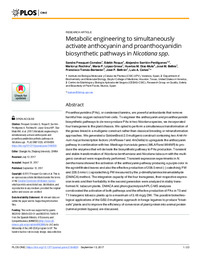Please use this identifier to cite or link to this item:
https://hdl.handle.net/11000/31416Full metadata record
| DC Field | Value | Language |
|---|---|---|
| dc.contributor.author | Fresquet-Corrales, Sandra | - |
| dc.contributor.author | Roque, Edelín | - |
| dc.contributor.author | SarrioÂn-Perdigones, Alejandro | - |
| dc.contributor.author | Rochina, Maricruz | - |
| dc.contributor.author | López-Gresa, María P. | - |
| dc.contributor.author | Diaz-Mula, Huertas Maria | - |
| dc.contributor.author | Bellés, José M. | - |
| dc.contributor.author | Tomás-Barberán, Francisco | - |
| dc.contributor.author | Beltrán, José P. | - |
| dc.contributor.author | Cañas, Luis A. | - |
| dc.contributor.other | Departamentos de la UMH::Biología Aplicada | es_ES |
| dc.date.accessioned | 2024-02-09T17:12:18Z | - |
| dc.date.available | 2024-02-09T17:12:18Z | - |
| dc.date.created | 2017-09-13 | - |
| dc.identifier.citation | PLoS ONE 12(9), 2017 | es_ES |
| dc.identifier.issn | 1932-6203 | - |
| dc.identifier.uri | https://hdl.handle.net/11000/31416 | - |
| dc.description.abstract | Proanthocyanidins (PAs), or condensed tannins, are powerful antioxidants that remove harmful free oxygen radicals from cells. To engineer the anthocyanin and proanthocyanidin biosynthetic pathways to de novo produce PAs in two Nicotiana species, we incorporated four transgenes to the plant chassis. We opted to perform a simultaneous transformation of the genes linked in a multigenic construct rather than classical breeding or retransformation approaches. We generated a GoldenBraid 2.0 multigenic construct containing two Antirrhinum majus transcription factors (AmRosea1 and AmDelila) to upregulate the anthocyanin pathway in combination with two Medicago truncatula genes (MtLAR and MtANR) to produce the enzymes that will derivate the biosynthetic pathway to PAs production. Transient and stable transformation of Nicotiana benthamiana and Nicotiana tabacum with the multigenic construct were respectively performed. Transient expression experiments in N. benthamiana showed the activation of the anthocyanin pathway producing a purple color in the agroinfiltrated leaves and also the effective production of 208.5 nmol (-) catechin/g FW and 228.5 nmol (-) epicatechin/g FW measured by the p-dimethylaminocinnamaldehyde (DMACA) method. The integration capacity of the four transgenes, their respective expression levels and their heritability in the second generation were analyzed in stably transformed N. tabacum plants. DMACA and phoroglucinolysis/HPLC-MS analyses corroborated the activation of both pathways and the effective production of PAs in T0 and T1 transgenic tobacco plants up to a maximum of 3.48 mg/g DW. The possible biotechnological applications of the GB2.0 multigenic approach in forage legumes to produce ªbloatsafe º plants and to improve the efficiency of conversion of plant protein into animal protein (ruminal protein bypass) are discussed. | es_ES |
| dc.format | application/pdf | es_ES |
| dc.format.extent | 23 | es_ES |
| dc.language.iso | eng | es_ES |
| dc.publisher | Public Library of Science | es_ES |
| dc.rights | info:eu-repo/semantics/openAccess | es_ES |
| dc.rights | Attribution-NonCommercial-NoDerivatives 4.0 Internacional | * |
| dc.rights.uri | http://creativecommons.org/licenses/by-nc-nd/4.0/ | * |
| dc.subject.other | CDU::5 - Ciencias puras y naturales::57 - Biología | es_ES |
| dc.title | Metabolic engineering to simultaneously activate anthocyanin and proanthocyanidin biosynthetic pathways in Nicotiana spp | es_ES |
| dc.type | info:eu-repo/semantics/article | es_ES |
| dc.relation.publisherversion | https://doi.org/10.1371/journal.pone.0184839 | es_ES |

View/Open:
3-Fresquet corrles plosone 2017.pdf
10,25 MB
Adobe PDF
Share:
.png)
